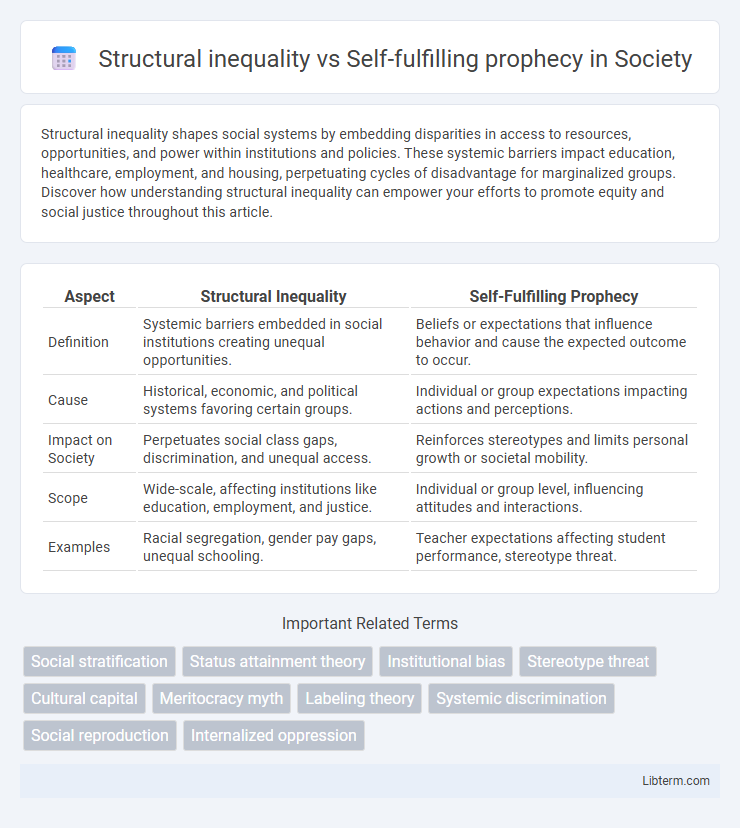Structural inequality shapes social systems by embedding disparities in access to resources, opportunities, and power within institutions and policies. These systemic barriers impact education, healthcare, employment, and housing, perpetuating cycles of disadvantage for marginalized groups. Discover how understanding structural inequality can empower your efforts to promote equity and social justice throughout this article.
Table of Comparison
| Aspect | Structural Inequality | Self-Fulfilling Prophecy |
|---|---|---|
| Definition | Systemic barriers embedded in social institutions creating unequal opportunities. | Beliefs or expectations that influence behavior and cause the expected outcome to occur. |
| Cause | Historical, economic, and political systems favoring certain groups. | Individual or group expectations impacting actions and perceptions. |
| Impact on Society | Perpetuates social class gaps, discrimination, and unequal access. | Reinforces stereotypes and limits personal growth or societal mobility. |
| Scope | Wide-scale, affecting institutions like education, employment, and justice. | Individual or group level, influencing attitudes and interactions. |
| Examples | Racial segregation, gender pay gaps, unequal schooling. | Teacher expectations affecting student performance, stereotype threat. |
Understanding Structural Inequality
Structural inequality refers to systemic disparities embedded within social, economic, and political institutions that disproportionately disadvantage specific groups based on race, gender, or class. Understanding structural inequality involves analyzing how historical policies, institutional practices, and cultural norms perpetuate unequal access to education, employment, and resources, thereby reinforcing social hierarchies. This framework contrasts with the self-fulfilling prophecy, which focuses on individual or group behavior shaped by internalized expectations rather than entrenched systemic barriers.
Defining the Self-Fulfilling Prophecy
The self-fulfilling prophecy is a psychological phenomenon where an individual's or group's belief about a situation influences their behavior in a way that causes the original expectation to come true. In the context of structural inequality, these prophecies reinforce existing social hierarchies by perpetuating negative stereotypes and limiting opportunities for marginalized groups. This cycle exacerbates disparities in education, employment, and social mobility, making it difficult to break free from systemic barriers.
Historical Roots of Structural Inequality
Structural inequality stems from entrenched historical processes such as colonization, slavery, and discriminatory legislation that systematically marginalized certain groups. These deep-rooted injustices created unequal access to resources, education, and economic opportunities that persist across generations. Self-fulfilling prophecies often emerge as marginalized communities internalize societal biases, reinforcing the very disparities produced by structural inequality.
Psychological Mechanisms of Self-Fulfilling Prophecies
Self-fulfilling prophecies operate through psychological mechanisms such as expectation formation, selective attention, and behavioral confirmation, where individuals unconsciously shape their actions to align with perceived beliefs or stereotypes. These cognitive biases reinforce pre-existing structural inequalities by perpetuating negative cycles, especially in marginalized communities. Understanding these mental processes reveals how societal structures and personal expectations interact to perpetuate disparities over time.
Education: Where Structures and Prophecies Collide
Structural inequality in education manifests through disparities in school funding, resource availability, and teacher quality, disproportionately affecting marginalized communities. Self-fulfilling prophecy occurs when educators' lowered expectations for these students lead to diminished academic performance, reinforcing existing disparities. The interplay between systemic barriers and predictive behaviors perpetuates educational inequities, highlighting the urgent need for systemic reforms and culturally responsive teaching practices.
Socioeconomic Status and Opportunity Gaps
Structural inequality perpetuates socioeconomic disparities by limiting access to quality education, healthcare, and employment opportunities, thereby widening opportunity gaps across communities. Self-fulfilling prophecy reinforces these gaps as individuals from lower socioeconomic statuses internalize negative expectations, leading to diminished academic achievement and reduced social mobility. Addressing both systemic barriers and psychological factors is crucial to closing opportunity gaps and promoting equitable socioeconomic outcomes.
The Role of Stereotypes in Shaping Outcomes
Stereotypes play a pivotal role in both structural inequality and self-fulfilling prophecies by reinforcing biased expectations that limit opportunities for marginalized groups. In structural inequality, these stereotypes are embedded within institutions, perpetuating systemic barriers in education, employment, and justice systems. In self-fulfilling prophecies, individuals internalize stereotypes, which negatively affect their performance and behavior, thus confirming the biased expectations and perpetuating social disparities.
Breaking the Cycle: Policy and Intervention
Targeted policies addressing structural inequality, such as equitable education funding and affordable housing initiatives, are essential for disrupting the self-fulfilling prophecy where marginalized groups internalize negative stereotypes. Interventions like mentorship programs and community support networks help reshape expectations and provide resources, empowering individuals to overcome systemic barriers. By combining institutional reforms with social support, breaking the cycle of disadvantage becomes a measurable outcome in reducing persistent inequality.
Case Studies: Real-World Consequences
Case studies in sociology reveal how structural inequality generates persistent disparities in education, employment, and healthcare access, entrenching marginalized groups in cycles of poverty. Self-fulfilling prophecies exacerbate these outcomes by influencing teacher expectations and employer biases, leading to lower performance and reduced opportunities for stigmatized individuals. For example, research on minority students shows lowered teacher expectations result in decreased academic achievement, illustrating the interaction between societal structures and psychological processes that perpetuate inequality.
Pathways Toward Equity and Empowerment
Structural inequality entrenches disparities in education, employment, and healthcare, limiting opportunities for marginalized groups and perpetuating systemic barriers. Self-fulfilling prophecy exacerbates these inequities by influencing individuals' expectations and behaviors, often leading to performance that confirms negative stereotypes. Pathways toward equity and empowerment involve disrupting these cycles through targeted policies, community-driven initiatives, and inclusive practices that foster resilience and access to resources.
Structural inequality Infographic

 libterm.com
libterm.com